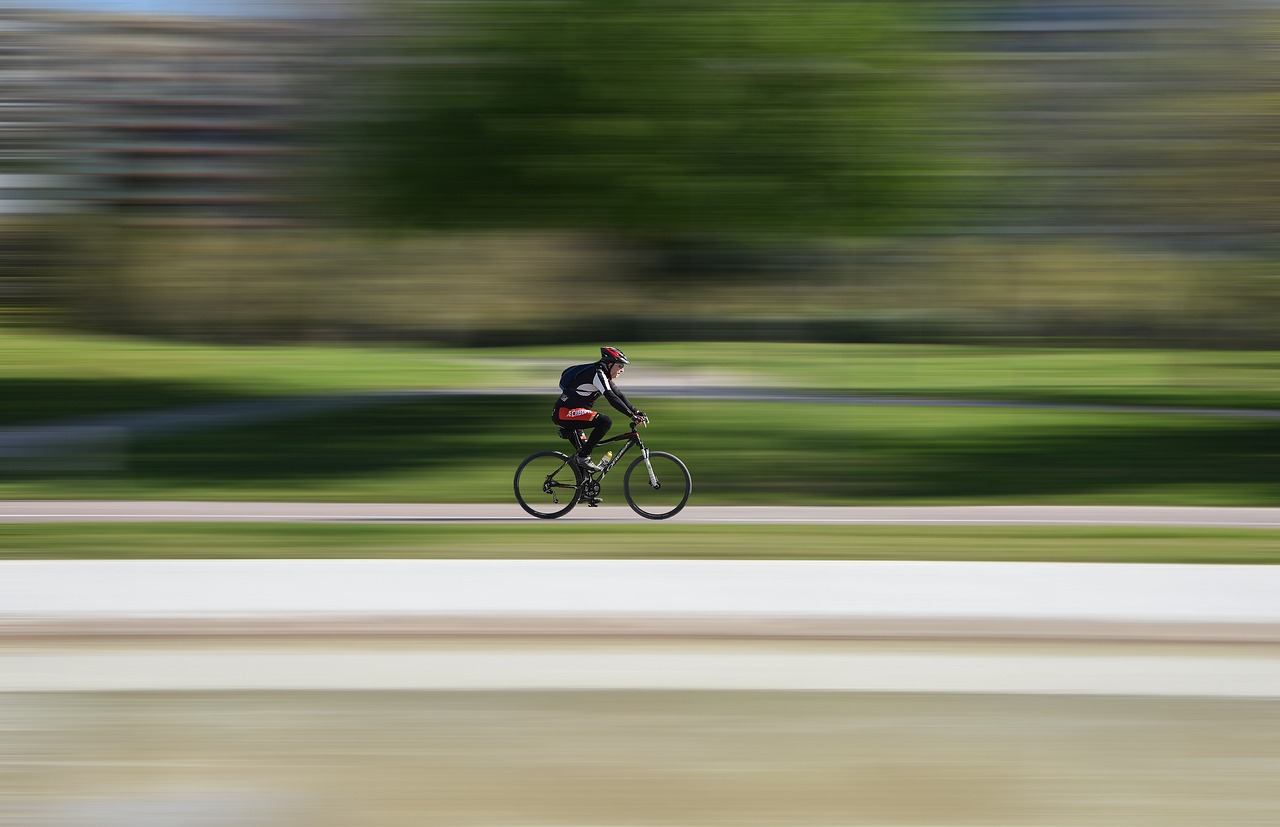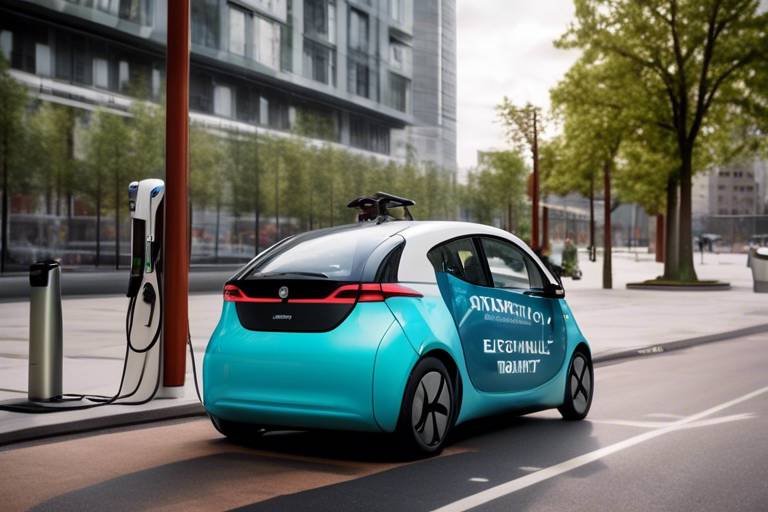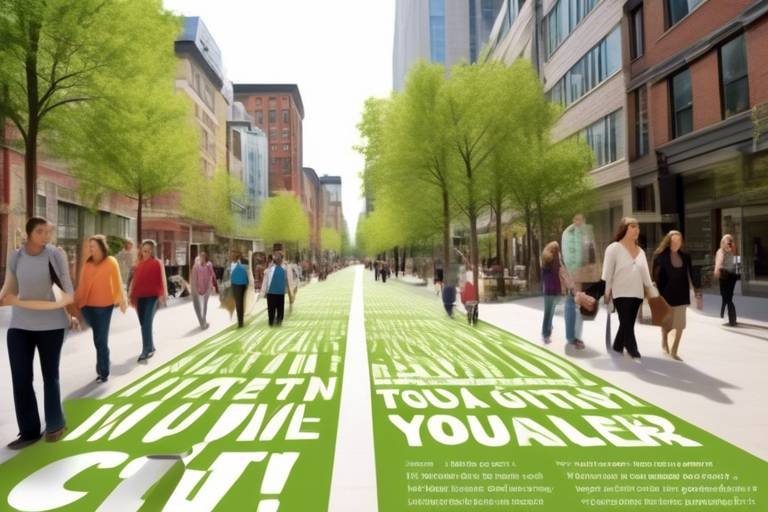Strategies for Encouraging Bicycle Usage in Urban Settings
In today's fast-paced world, cities are increasingly recognizing the importance of promoting sustainable transportation methods. One of the most effective ways to do this is by encouraging bicycle usage. Not only does cycling reduce traffic congestion and pollution, but it also promotes a healthier lifestyle for residents. So, how can urban environments foster a culture of cycling? This article dives deep into various strategies that can transform our cities into bike-friendly havens, focusing on infrastructure improvements, community initiatives, and policy changes that pave the way for a more bicycle-centric lifestyle.
When it comes to encouraging cycling, the first step is to develop a robust bicycle infrastructure. Imagine trying to ride a bike on a busy road without any designated lanes or safe crossings—it’s not only daunting but also dangerous! Cities that have successfully integrated dedicated bike lanes, bike parking facilities, and safe crossings have seen a significant increase in bicycle usage. For instance, cities like Amsterdam and Copenhagen have set benchmarks with their extensive cycling networks, making it easy and safe for people to choose biking over driving. Investing in infrastructure isn't just about creating lanes; it's about creating a culture of safety and accessibility for cyclists of all ages.
Building a cycling culture isn't solely about infrastructure; it also requires community involvement. Engaging residents through various programs and events can highlight the benefits of cycling as a sustainable mode of transportation. For example, organizing group rides can help foster a sense of community among cyclists. These rides not only encourage new cyclists to join but also create a supportive environment where experienced cyclists can share tips and experiences. Think of it as a social gathering on wheels—everyone is welcome, and the more, the merrier!
Group rides can be a game-changer for those hesitant to take up cycling. They provide a platform for individuals to connect, share their passion for biking, and learn from one another. Imagine a weekend morning, where a diverse group of cyclists gathers at a local park, ready to explore the city together. The camaraderie built during these rides can be incredibly motivating, making new cyclists feel less intimidated and more inclined to hop on their bikes regularly.
Another effective strategy is hosting family-oriented cycling events. These events are designed to attract participants of all ages, promoting cycling as a fun, healthy activity for families. Picture a vibrant festival filled with activities, games, and, of course, cycling! Such events not only promote cycling but also instill lifelong habits in children, encouraging them to view biking as a natural part of their lives. By creating a fun atmosphere, families can bond while discovering the joys of riding together.
Local cycling clubs can play a vital role in building a supportive cycling community. These clubs offer resources, training sessions, and social events that cater to both novice and experienced cyclists. Joining a local cycling club can feel like gaining a second family—one that shares your passion for biking and supports your journey, whether you're just starting or looking to improve your skills. By promoting these clubs, cities can help create networks of cyclists who encourage one another, share routes, and advocate for better cycling conditions.
Education is another crucial element in encouraging bicycle usage. Educating cyclists about road safety, proper biking techniques, and the rules of the road can significantly reduce accidents and increase confidence among urban cyclists. Imagine a workshop where participants learn how to navigate traffic, understand bike maintenance, and even practice emergency braking techniques. Such initiatives empower cyclists to ride safely and confidently, making them more likely to choose biking as their primary mode of transportation.
Implementing supportive policies can have a profound impact on bicycle usage. Local governments can adopt various policy changes and incentives to encourage more residents to choose cycling. For instance, offering subsidies for purchasing bicycles can lower financial barriers, making it easier for individuals to invest in cycling as a primary mode of transportation. Think of it as a nudge towards a healthier lifestyle—when the financial burden is alleviated, more people are likely to embrace cycling.
Subsidizing bicycle purchases can be a powerful tool in promoting cycling. By reducing the cost of bikes, local governments can make cycling more accessible to everyone. Imagine a scenario where a single mother can afford a bike for her child because of a subsidy program. This not only benefits the family but also contributes to a larger community of cyclists. When people see others biking, it normalizes the practice and encourages them to do the same.
Bike share programs are another innovative way to promote cycling in urban environments. These programs provide convenient access to bicycles for short trips, allowing residents to hop on a bike without the need for ownership. Think of it as an urban library for bikes—grab one when you need it, return it when you’re done! Successful bike share models, like those in cities such as San Francisco and New York, have shown that when bikes are readily available, more people will choose to ride them. This not only helps reduce traffic congestion but also fosters a culture of cycling.
Q: How can I get involved in local cycling initiatives?
A: Look for local cycling clubs or community events in your area. Many cities have websites dedicated to promoting cycling where you can find information on upcoming events.
Q: Are there any safety tips for new cyclists?
A: Absolutely! Always wear a helmet, obey traffic signals, and make yourself visible to drivers. Joining a safety workshop can also be beneficial.
Q: What should I do if my city lacks bike lanes?
A: Advocate for change! Attend city council meetings, start a petition, and collaborate with local cycling organizations to push for better infrastructure.

Improving Bicycle Infrastructure
When it comes to promoting cycling in urban areas, is not just a good idea—it's essential. Imagine a city where cyclists can glide through dedicated bike lanes, park their bikes securely, and cross streets safely without the fear of being hit by a car. Sounds dreamy, right? Well, this dream can become a reality with thoughtful planning and execution. Cities around the world have seen remarkable transformations when they prioritize cycling infrastructure, leading to increased bicycle usage and a healthier, happier population.
One of the most effective strategies is the development of dedicated bike lanes. These lanes separate cyclists from motor vehicle traffic, significantly reducing the risk of accidents. Cities like Amsterdam and Copenhagen have set the gold standard, boasting extensive networks of protected bike lanes that encourage people to hop on their bikes instead of driving. But it's not just about having lanes; it's about ensuring they are well-maintained and clearly marked. A well-designed bike lane can make a cyclist feel like they own the road, which is a powerful motivator for more people to cycle.
Alongside bike lanes, bike parking facilities are crucial. Imagine arriving at your destination only to find nowhere to park your bike safely. Frustrating, right? By installing secure bike racks and bike lockers in strategic locations, cities can alleviate this problem. It's about making cycling a convenient option. Some cities have even implemented multi-story bike parking to maximize space in crowded areas. This not only encourages cycling but also enhances the overall aesthetic of the urban landscape.
Safe crossings are another critical component of bicycle infrastructure. Implementing bike-friendly traffic signals and crosswalks can make a world of difference. For instance, cities can use bike boxes, which provide a designated area for cyclists to wait at traffic lights, ensuring they are visible to drivers. This simple yet effective solution can significantly reduce accidents and instill confidence in cyclists, especially those who are new to biking.
To illustrate the impact of these infrastructure improvements, let’s take a look at a few successful projects:
| City | Infrastructure Improvement | Impact on Cycling Rates |
|---|---|---|
| Copenhagen | Extensive bike lane network | Over 60% of residents commute by bike |
| Portland | Protected bike lanes | Increased cycling by 50% in five years |
| Amsterdam | Multi-story bike parking | Over 40% of trips made by bike |
As we can see, investing in bicycle infrastructure pays off. Not only does it encourage more people to cycle, but it also contributes to a reduction in traffic congestion and lower emissions. In a world where climate change is a pressing issue, cycling offers a sustainable alternative to traditional transportation methods.
In conclusion, improving bicycle infrastructure is a multifaceted approach that requires collaboration between city planners, local governments, and the community. By creating dedicated bike lanes, secure parking, and safe crossings, cities can foster a cycling culture that benefits everyone. So, the next time you think about how to make your city more bike-friendly, remember: it's all about the infrastructure!

Community Engagement Initiatives
Engaging the community is a cornerstone of fostering a vibrant cycling culture in urban environments. When residents feel connected to their neighborhoods and see cycling as a viable transportation option, they are more likely to hop on their bikes. This is where community engagement initiatives come into play. By organizing events and programs that encourage participation, cities can create a sense of togetherness that not only promotes cycling but also enhances the overall quality of life.
One effective way to engage the community is through organized group rides. These rides are not just about pedaling through the streets; they are about building a community among cyclists. Imagine a group of friends, old and new, cruising through the city together, sharing stories, and enjoying the fresh air. Group rides can significantly lower the intimidation factor for new cyclists, making them feel welcome and supported. They also provide a platform for experienced cyclists to share tips and create a network of support, which is invaluable for anyone looking to improve their skills or confidence.
Another exciting avenue for community engagement is hosting family-friendly events. These gatherings can range from fun cycling festivals to educational workshops that teach families how to ride safely and responsibly. Picture a sunny Saturday afternoon filled with laughter, games, and bicycle races for kids and adults alike. Such events not only promote cycling as a fun activity but also instill healthy habits in children from a young age. When families participate together, they create lasting memories and a culture of cycling that can be passed down through generations.
Moreover, promoting local cycling clubs is an excellent strategy to build a supportive cycling community. These clubs serve as a hub for cyclists of all levels, offering resources, guidance, and camaraderie. They often organize regular rides, workshops, and social events that cater to both novice and experienced cyclists. By joining a local club, individuals can connect with others who share their passion for cycling, making the experience more enjoyable and less isolating. The sense of belonging that comes from being part of a club can be a powerful motivator for individuals to ride more frequently.
To further enhance community engagement, cities can implement educational and safety programs. These initiatives are crucial for teaching cyclists about road safety, proper biking techniques, and the rules of the road. Workshops can be organized to cover topics such as defensive riding, hand signals, and how to navigate urban traffic safely. When cyclists are well-informed, they are more confident on the road, which can lead to a decrease in accidents and a more positive perception of cycling within the community.
In conclusion, community engagement initiatives are vital for promoting bicycle usage in urban areas. By fostering a sense of community through organized rides, family-friendly events, local cycling clubs, and educational programs, cities can create an environment where cycling is not just an activity but a lifestyle. The more connected individuals feel to their community and the cycling culture, the more likely they are to choose their bikes as their primary mode of transportation.
- Why is community engagement important for cycling? Community engagement fosters a sense of belonging and encourages more people to participate in cycling, creating a supportive environment.
- What types of events can promote cycling? Family-friendly events, organized group rides, and cycling workshops are effective in promoting cycling within communities.
- How can local cycling clubs help? Local cycling clubs provide resources, support, and a sense of community for cyclists of all levels.
- What educational programs are beneficial for cyclists? Programs that teach road safety, biking techniques, and traffic rules can significantly enhance cyclist confidence and safety.

Organizing Group Rides
When it comes to fostering a vibrant cycling culture in urban areas, one of the most effective strategies is organizing group rides. Imagine this: a sunny Saturday morning, cyclists of all ages and skill levels gathering at a local park, laughter and excitement filling the air as they prepare to embark on a journey together. Group rides not only promote cycling as a viable mode of transportation but also create a sense of community that can be incredibly encouraging for both novice and seasoned cyclists.
One of the key benefits of organizing group rides is the opportunity they provide for new cyclists to gain confidence. Many individuals may feel intimidated by the thought of cycling alone in busy urban environments. However, when they join a group, they can ride alongside experienced cyclists who can offer tips, share routes, and create a supportive atmosphere. This camaraderie can be just the boost someone needs to take the plunge and embrace cycling as part of their daily routine.
Moreover, group rides can be tailored to meet the needs of various participants. For instance, you might consider organizing:
- Beginner Rides: Slower-paced rides designed for those just starting out, focusing on basic skills and safety.
- Family Rides: Fun and engaging routes suitable for all ages, complete with stops at parks or ice cream shops.
- Advanced Rides: More challenging routes for experienced cyclists looking to push their limits.
By offering these diverse options, organizers can ensure that everyone feels included and has a chance to participate, regardless of their cycling experience. Additionally, group rides can serve as a platform for education. During these rides, experienced cyclists can share valuable knowledge about road safety, bike maintenance, and the best local trails, further enhancing the skills and confidence of all participants.
Another exciting aspect of group rides is the potential for community building beyond just cycling. Participants often form friendships, share stories, and create lasting memories. This social aspect can transform cycling from a solitary activity into a vibrant community experience. Consider organizing themed rides or special events, such as charity rides or holiday-themed outings, to keep the momentum going and attract more participants.
As cities continue to evolve, it’s crucial to leverage these group rides as a way to advocate for better cycling infrastructure. When large groups of cyclists hit the streets, they draw attention to the need for safer roads and dedicated bike lanes. This visibility can lead to increased pressure on local governments to invest in cycling-friendly initiatives, ultimately benefiting the entire community.
In conclusion, organizing group rides is not just about getting people on bikes; it’s about creating a supportive, engaging, and fun environment that encourages cycling as a lifestyle choice. Whether you’re a seasoned cyclist or just starting your biking journey, participating in group rides can open up a world of opportunities, friendships, and adventures. So, grab your helmet, rally your friends, and hit the road together—because the journey is always better with company!
Q: How do I find group rides in my area?
A: Many local cycling clubs and community organizations host regular group rides. You can also check social media platforms and cycling apps for events in your area.
Q: What should I bring on a group ride?
A: Be sure to bring your bike, a helmet, water, snacks, and any necessary tools for minor repairs. It's also a good idea to wear comfortable clothing and shoes suitable for cycling.
Q: Are group rides safe?
A: Yes, group rides can be very safe, especially when organized by experienced cyclists who prioritize safety. Riders are typically instructed to follow traffic rules and ride in a predictable manner.
Q: Do I need to be an experienced cyclist to join a group ride?
A: Absolutely not! Many group rides cater to cyclists of all skill levels, and beginners are always welcome. It's a great way to learn and gain confidence.

Family-Friendly Events
When it comes to promoting cycling, are a fantastic way to get everyone involved, from toddlers to grandparents. Imagine a sunny Saturday morning, families gathering at a local park, excitedly preparing their bikes for a day of fun. These events not only encourage families to ride together but also create lasting memories that can foster a love for cycling in children. By making cycling a family affair, we can cultivate a generation of cyclists who see biking not just as a mode of transport, but as a joyful activity.
One of the most effective ways to engage families is through organized rides that cater to all skill levels. For instance, a family bike festival could feature various activities such as guided rides, bike decorating contests, and even safety workshops tailored for kids. These events can be structured to include:
- Fun Rides: Short, leisurely rides designed for families, allowing everyone to enjoy the scenery without the pressure of speed.
- Obstacle Courses: Safe, controlled environments where kids can learn essential biking skills while having a blast.
- Educational Booths: Stations that teach families about bike safety, maintenance, and the environmental benefits of cycling.
Moreover, hosting family-oriented competitions can also spark excitement. Events like a “family relay race” or “best family costume on a bike” can add a fun and competitive edge. These activities not only promote cycling but also strengthen family bonds, making biking a shared passion.
It's essential to ensure that these events are accessible to everyone. Providing free bike rentals or partnerships with local bike shops can help lower barriers for families who may not own bikes. Additionally, offering refreshments, entertainment, and even prizes can make the day more enjoyable and encourage more families to participate. After all, who doesn’t love a good freebie?
In conclusion, family-friendly cycling events are a powerful strategy for encouraging biking in urban areas. By creating an environment that celebrates cycling as a fun and healthy activity, we can inspire families to adopt cycling as a regular part of their lives. So, grab your helmets, gather your loved ones, and let’s hit the road together!
- What age is suitable for children to start cycling? Most children can start learning to ride a bike around the age of 4 or 5, depending on their physical coordination and comfort level.
- Are family-friendly cycling events safe? Yes, these events are designed with safety in mind, often featuring designated routes and safety workshops to ensure a secure environment.
- How can I find family-friendly cycling events in my area? Check local community boards, social media groups, or websites dedicated to cycling events for upcoming family-oriented activities.

Promoting Local Cycling Clubs
Local cycling clubs are the heartbeat of the cycling community, acting as a vibrant hub for both novice and experienced cyclists. These clubs not only provide a platform for individuals to connect over their shared passion for biking but also offer invaluable resources and support. Imagine stepping into a world where every ride feels like an adventure, where you can meet friends who share your enthusiasm for the open road. That's the magic of local cycling clubs!
One of the most significant benefits of joining a local cycling club is the sense of camaraderie it fosters. Members often organize group rides that cater to various skill levels, ensuring that everyone, from beginners to seasoned pros, feels included. This supportive environment can be a game-changer for those who may feel intimidated by cycling alone. Plus, riding with a group not only enhances safety but also makes the experience more enjoyable. After all, who wouldn’t want to share a laugh or two while tackling a challenging hill?
Moreover, local cycling clubs are instrumental in promoting cycling as a sustainable mode of transport. They often engage in community outreach programs that educate the public about the benefits of cycling, such as reduced traffic congestion and lower carbon emissions. Many clubs partner with local governments to advocate for better cycling infrastructure, making it easier and safer for everyone to ride. By participating in these initiatives, club members can make a tangible impact on their communities.
Additionally, local cycling clubs frequently host events that cater to a wide range of interests. From charity rides to competitive races, these events not only bring cyclists together but also help raise funds for local causes. For instance, a club might organize a charity ride to support a local school or environmental initiative. This not only boosts community spirit but also showcases the positive role cycling can play in societal development.
In essence, promoting local cycling clubs is about building a network of support and enthusiasm that can transform the urban landscape. By encouraging individuals to join these clubs, we can cultivate a culture of cycling that celebrates health, community, and environmental responsibility. So, if you're looking to enhance your cycling experience, consider finding a local club near you. You might just discover a whole new world of adventure!
- What are the benefits of joining a local cycling club? Joining a local cycling club provides opportunities for social interaction, skill development, and community engagement. It can also enhance your cycling experience through group rides and events.
- How do I find a cycling club near me? You can search online for local cycling clubs, check community bulletin boards, or ask at local bike shops for recommendations.
- Are cycling clubs only for experienced cyclists? Not at all! Most clubs welcome cyclists of all skill levels and often organize rides specifically for beginners.
- What types of events do cycling clubs typically host? Cycling clubs may host group rides, charity events, races, and educational workshops, among other activities.

Education and Safety Programs
Education and safety programs play a pivotal role in transforming urban cycling into a safe and enjoyable experience. When we think about encouraging more people to hop on their bikes, it’s crucial to address the fears and uncertainties that often hold potential cyclists back. Whether it's the fear of navigating busy streets or the worry about road safety, these programs are designed to equip cyclists with the knowledge and skills they need to ride confidently. By fostering a culture of safety and awareness, we can significantly increase the number of people who choose cycling as a viable mode of transportation.
One of the most effective ways to implement these programs is through community workshops that focus on essential biking skills. These workshops can cover a range of topics, from basic bike maintenance to understanding traffic laws. Imagine a Saturday morning where families gather in a local park, learning how to properly adjust their bike seats, check tire pressure, and even fix a flat tire! Such hands-on experiences not only build confidence but also empower individuals to take ownership of their cycling experience.
Moreover, safety education should also encompass the importance of visibility and defensive riding techniques. Cyclists need to be aware of their surroundings and understand how to react in various traffic scenarios. Programs that simulate real-life situations, such as navigating intersections or dealing with aggressive drivers, can be incredibly beneficial. By teaching cyclists to anticipate potential hazards, we can help them develop a proactive mindset that prioritizes safety.
To illustrate the effectiveness of these programs, let’s take a look at some successful case studies from urban areas that have seen a marked increase in cycling safety and usage. For instance, cities that have integrated educational campaigns into their cycling infrastructure have reported a significant decrease in accidents. According to a recent study, cities that implemented comprehensive safety education programs saw a 30% reduction in cycling-related injuries within the first year. This statistic alone highlights the importance of education in promoting safe cycling practices.
In addition to workshops and hands-on training, it’s also vital to engage with schools to introduce cycling safety into the curriculum. Incorporating biking education into physical education classes or after-school programs can instill good habits from a young age. Children who learn about road safety and responsible cycling are more likely to continue these practices into adulthood. Imagine a future where cycling is second nature to everyone, just like crossing the street safely!
Lastly, collaboration with local law enforcement can enhance the impact of these education programs. Police officers can conduct bike safety checks and provide tips on how to stay safe while riding. This not only builds trust within the community but also reinforces the message that safety is a shared responsibility. When cyclists feel supported by their local authorities, they are more likely to engage in cycling as a regular activity.
In conclusion, education and safety programs are essential for fostering a thriving cycling culture in urban settings. By providing the necessary knowledge and skills, we can alleviate fears, build confidence, and ultimately encourage more people to embrace cycling. The road to a bike-friendly city starts with informed and empowered cyclists, ready to take on the streets with safety and enthusiasm.
- What types of education programs are available for cyclists?
Many communities offer workshops, safety classes, and hands-on training sessions that cover bike maintenance, traffic laws, and defensive riding techniques.
- How can I get involved in local cycling education initiatives?
You can check with local cycling clubs, community centers, or city government websites for upcoming workshops and volunteer opportunities.
- Are there any age restrictions for participating in these programs?
Most programs are designed for all ages, with specific sessions tailored for children, teens, and adults.
- How do education programs impact cycling safety?
Education programs significantly reduce cycling-related accidents by equipping cyclists with knowledge about road safety and proper biking techniques.

Policy Changes and Incentives
When it comes to promoting bicycle usage in urban areas, can be game-changers. Local governments hold the keys to unlocking a bike-friendly environment through strategic planning and supportive policies. Imagine a city where biking isn't just a hobby but a primary mode of transportation—this vision can become a reality with the right initiatives. By implementing policies that promote cycling, cities can not only reduce traffic congestion but also improve public health and environmental sustainability.
One of the most effective ways to encourage cycling is by subsidizing bicycle purchases. Financial barriers often deter potential cyclists from investing in a bike. By offering subsidies, local governments can make bicycles more accessible to a broader range of residents. For instance, a city might provide a 20% discount on bike purchases for low-income families or first-time buyers. This approach not only incentivizes individuals to buy bicycles but also helps to create a more diverse cycling community. The impact of such programs can be profound, as seen in cities that have successfully implemented similar initiatives.
Another innovative solution is the introduction of bike share programs. These programs allow residents and visitors to access bicycles for short trips without the need for ownership. Imagine a network of bike stations sprinkled throughout the city, where anyone can grab a bike for a quick ride to the grocery store or a leisurely trip through the park. Such systems have been successful in cities like New York and Paris, where bike share programs have dramatically increased the number of people cycling. These programs not only provide convenience but also encourage people to consider cycling as a viable option for their daily commutes.
To further support these initiatives, local governments can also implement incentive programs for businesses that promote cycling among their employees. Companies could receive tax breaks or grants for offering bike parking, showers, and changing facilities, encouraging their workforce to bike to work. This creates a ripple effect, where businesses become active participants in fostering a cycling culture, leading to healthier employees and a more engaged community.
However, it's not just about financial incentives. Policy changes need to be coupled with education and awareness campaigns. Cities should invest in programs that inform residents about the benefits of cycling, not just for personal health but also for environmental sustainability. Campaigns can include workshops, community meetings, and social media outreach to highlight how cycling can reduce carbon footprints and improve air quality. By fostering a culture of cycling through education, cities can see a more significant shift towards bike-friendly attitudes.
In summary, the path to increasing bicycle usage in urban areas is paved with thoughtful policy changes and attractive incentives. By subsidizing bike purchases, implementing bike share programs, and encouraging businesses to support cycling, cities can create an environment where cycling is not only feasible but also desirable. The transformation won’t happen overnight, but with consistent efforts, we can envision a future where bicycles are a common sight on our streets, contributing to healthier communities and a cleaner planet.
- What are bike share programs? Bike share programs allow users to rent bicycles for short periods, making cycling accessible without the need for ownership.
- How do subsidies for bicycles work? Subsidies reduce the cost of purchasing a bicycle, making it more affordable for individuals, especially those from low-income backgrounds.
- What are the benefits of cycling for the community? Cycling reduces traffic congestion, improves public health, and contributes to environmental sustainability.

Subsidizing Bicycle Purchases
One of the most effective ways to encourage more people to embrace cycling as a primary mode of transportation is by . Imagine walking into a store and seeing a shiny new bike that promises freedom, fitness, and fun, but then realizing the price tag makes it feel more like a dream than a reality. By offering financial assistance, local governments can break down this barrier, making cycling accessible to a wider audience. This initiative not only promotes healthier lifestyles but also contributes to reducing traffic congestion and lowering carbon emissions.
Consider the impact of subsidies in cities where they have been implemented. For instance, cities like Amsterdam and Copenhagen have seen significant increases in bicycle usage thanks to various financial incentives. These programs often include direct subsidies for purchasing new bicycles, as well as discounts on accessories like helmets, lights, and locks. The financial relief can make a substantial difference, especially for low-income families who might otherwise opt for less sustainable forms of transportation.
Furthermore, the implementation of subsidies can take various forms. For instance, a city might offer:
- Direct Financial Assistance: A percentage off the purchase price of a bicycle.
- Tax Credits: Incentives that reduce the overall tax burden for individuals who purchase bikes.
- Partnerships with Local Retailers: Collaborations that provide discounts or special deals for residents.
These subsidies can be particularly effective when paired with educational campaigns that highlight the benefits of cycling. By informing potential cyclists about the health, environmental, and economic advantages of biking, local governments can create a compelling case for making the switch. This holistic approach not only incentivizes purchases but also fosters a culture of cycling that can lead to long-term behavioral change.
In addition, implementing a subsidy program can stimulate local economies. When residents purchase bicycles, they often buy accessories and maintenance services from local shops, creating a ripple effect that benefits the community. This economic boost can be significant, especially in urban areas where small businesses thrive on local patronage.
In summary, subsidizing bicycle purchases is not just about making bikes more affordable; it's about reshaping urban mobility and promoting a healthier lifestyle for all residents. By investing in such initiatives, cities can pave the way for a more bike-friendly environment that encourages sustainable transportation choices. As we look to the future, it's clear that financial incentives will play a crucial role in how we navigate our urban landscapes.
Q: How do subsidies for bicycle purchases work?
A: Subsidies typically involve financial assistance that reduces the cost of purchasing a bicycle. This can be in the form of direct discounts, tax credits, or partnerships with local retailers.
Q: Who is eligible for bicycle purchase subsidies?
A: Eligibility can vary by program, but many subsidies aim to assist low to moderate-income individuals and families, promoting cycling as an affordable transportation option.
Q: Can subsidies also apply to bicycle accessories?
A: Yes, many programs extend their subsidies to include essential accessories such as helmets, locks, and lights to ensure cyclists are safe and well-equipped.
Q: Are there any successful examples of cities implementing these subsidies?
A: Absolutely! Cities like Amsterdam and Copenhagen have successfully implemented various forms of bicycle purchase subsidies, resulting in increased cycling rates and a more sustainable urban environment.

Implementing Bike Share Programs
Bike share programs have revolutionized urban transportation by providing a convenient and accessible way for residents and visitors to navigate city streets on two wheels. Imagine being able to hop on a bike just a few blocks from your home or office, zipping past traffic jams, and arriving at your destination feeling invigorated rather than stressed. This is the magic of bike share programs, and they play a pivotal role in promoting cycling as a viable mode of transport.
At the heart of a successful bike share program is convenience. Users can easily rent bikes from strategically placed docking stations throughout the city. This accessibility means that whether you’re heading to work, running errands, or exploring the city, a bike is never far away. Many programs offer mobile apps that allow users to locate nearby bikes, check availability, and even unlock them with a simple tap on their phones. This tech-savvy approach not only appeals to younger generations but also makes cycling more approachable for everyone.
Moreover, bike share programs can significantly reduce the number of cars on the road, leading to less congestion and improved air quality. By providing an affordable alternative to driving, these programs encourage people to leave their cars at home. For instance, a study conducted in several major cities found that bike share users reported a decrease in their reliance on personal vehicles, leading to a notable reduction in traffic-related emissions.
However, implementing a bike share program is not without its challenges. Cities must consider factors such as bike maintenance, station placement, and user safety. A well-planned program includes regular maintenance checks to ensure that bikes are in good working order and that docking stations are stocked with available bikes. Additionally, cities should prioritize placing stations in high-traffic areas, near public transit hubs, and in neighborhoods with limited access to other forms of transportation.
To illustrate the effectiveness of bike share programs, let’s take a look at a few successful examples:
| City | Year Launched | Bikes Available | Annual Rides |
|---|---|---|---|
| New York City | 2013 | 12,000 | 17 million |
| San Francisco | 2013 | 5,000 | 1.5 million |
| Washington D.C. | 2010 | 4,300 | 2 million |
These statistics showcase the popularity and impact of bike share programs in urban settings. The numbers speak for themselves, demonstrating that when cities invest in bike sharing, they reap the benefits in terms of increased cycling rates and reduced traffic congestion.
As we look to the future, it’s clear that bike share programs can play a crucial role in creating more sustainable urban environments. By prioritizing cycling infrastructure and integrating these programs with public transport, cities can foster a culture of cycling that not only enhances mobility but also promotes a healthier lifestyle. So, the next time you find yourself in a bustling city, consider hopping on a bike share bike. You might just discover a new favorite way to explore!
- What is a bike share program? A bike share program allows users to rent bicycles for short periods, typically through a network of docking stations located throughout a city.
- How do I use a bike share program? Users can locate nearby bikes using a mobile app, rent one by paying a fee, and then return it to any docking station within the network.
- Are bike share programs safe? Yes, bike share programs often include safety features such as helmets for rent, safety tips in their apps, and well-maintained bikes.
- How much does it cost to use a bike share program? Costs vary by city and program but typically include a one-time rental fee and additional charges based on the duration of the ride.
Frequently Asked Questions
- What are the benefits of cycling in urban areas?
Cycling in urban settings offers numerous benefits, including reduced traffic congestion, lower pollution levels, and improved public health. It’s a great way to stay active while also contributing to a cleaner environment. Plus, cycling can be a more efficient way to navigate through city traffic!
- How can cities improve bicycle infrastructure?
Cities can enhance bicycle infrastructure by constructing dedicated bike lanes, providing ample bike parking, and ensuring safe crossings. Successful projects often involve community input to create a network that meets the needs of cyclists, making it safer and more appealing to ride.
- What role do community initiatives play in promoting cycling?
Community initiatives are vital for fostering a cycling culture. Programs like organized group rides and family-friendly events help engage residents, making cycling a fun and social activity. These initiatives create a supportive environment that encourages more people to take up cycling.
- Are there educational programs for cyclists?
Yes! Many cities offer educational programs that focus on road safety and proper biking techniques. These programs aim to reduce accidents and boost the confidence of cyclists, particularly new riders who may feel intimidated by urban traffic.
- How can policy changes encourage more people to cycle?
Policy changes such as subsidizing bicycle purchases and implementing bike share programs can significantly increase cycling rates. Financial incentives make cycling more accessible, while bike share programs provide convenient options for those who may not own a bicycle.
- What are bike share programs?
Bike share programs allow residents and visitors to rent bicycles for short trips, making it easier to get around without the need for ownership. These programs are often strategically placed throughout urban areas, promoting cycling as a viable transportation option.



















